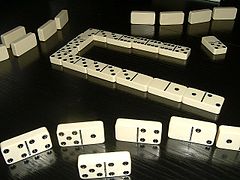
Back Batèe ACE ضومنة Arabic دومينو ARZ Dominó AST Domino Azerbaijani دومینو AZB Даміно Byelorussian Gaplé' BEW Домино (игра) Bulgarian Domino Breton
 | |
| Genres | Tile-based game |
|---|---|
| Players | 2 to 4 |
| Playing time | less than 15 minutes |
Dominoes is a family of tile-based games played with gaming pieces. Each domino is a rectangular tile, usually with a line dividing its face into two square ends. Each end is marked with a number of spots (also called pips or dots) or is blank. The backs of the tiles in a set are indistinguishable, either blank or having some common design. The gaming pieces make up a domino set, sometimes called a deck or pack. The traditional European domino set consists of 28 tiles, also known as pieces, bones, rocks, stones, men, cards or just dominoes, featuring all combinations of spot counts between zero and six. A domino set is a generic gaming device, similar to playing cards or dice, in that a variety of games can be played with a set. Another form of entertainment using domino pieces is the practice of domino toppling.

The earliest mention of dominoes is from Song dynasty China found in the text Former Events in Wulin by Zhou Mi (1232–1298).[1] Modern dominoes first appeared in Italy during the 18th century, but they differ from Chinese dominoes in a number of respects, and there is no confirmed link between the two. European dominoes may have developed independently, or Italian missionaries in China may have brought the game to Europe.[2]: 181
The name "domino" is probably derived from the resemblance to a kind of carnival costume worn during the Venetian Carnival, often consisting of a black-hooded robe and a white mask.[3][4] Despite the coinage of the word "polyomino" as a generalization, there is no connection between the word "domino" and the number 2 in any language. The most commonly played domino games are Domino Whist, Matador, and Muggins (All Fives). Other popular forms include Texas 42, Chicken Foot, Concentration, Double Fives, and Mexican Train.[2]: 181–182 In Britain, the most popular league and pub game is Fives and Threes.
Dominoes have sometimes been used for divination, such as bone throwing in Chinese culture and in the African diaspora.[5]
- ^ Lo, Andrew. "The Game of Leaves: An Inquiry into the Origin of Chinese Playing Cards," Bulletin of the School of Oriental and African Studies, University of London, Vol. 63, No. 3 (2000): 389-406.
- ^ a b Rodney P. Carlisle (2 April 2009). Encyclopedia of Play. SAGE. ISBN 978-1-4129-6670-2. Retrieved 5 October 2012.
- ^ "Pink Dominoes". www.kiplingsociety.co.uk. Retrieved 24 December 2018.
- ^ A domino is a kind of hood worn by the canons of a cathedral church. Later, the name was given to a mourning-veil for women and later still to half-masks worn by women when travelling or at a masquerade, for disguise. A domino was a masquerade-dress worn for disguise by ladies and gentlemen, and consisting of an ample cloak or mantle with wide sleeves and a hood removable at pleasure. It was usually made of black silk, but sometimes of other colours and materials.[The Probert Encyclopaedia]
- ^ "De Bones". The Portico Library. 19 March 2021. Retrieved 29 November 2022.
© MMXXIII Rich X Search. We shall prevail. All rights reserved. Rich X Search